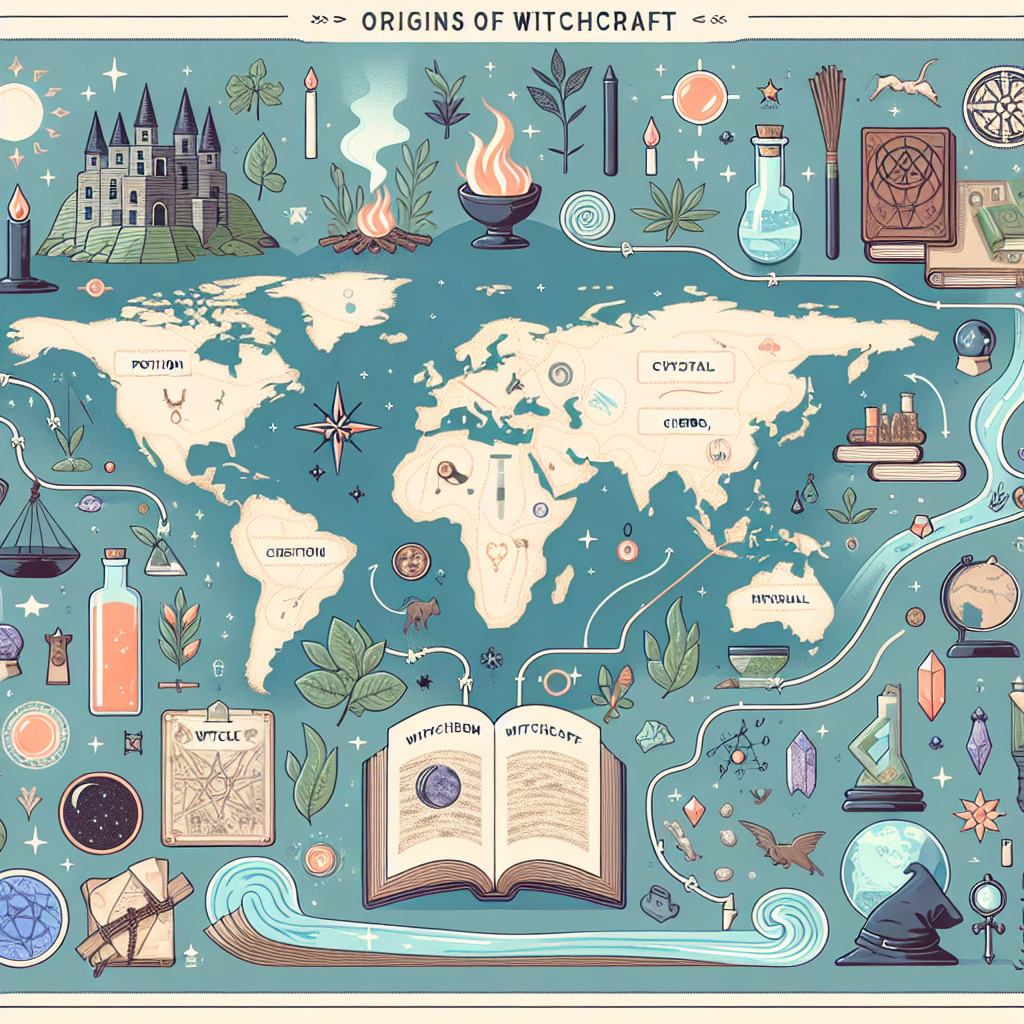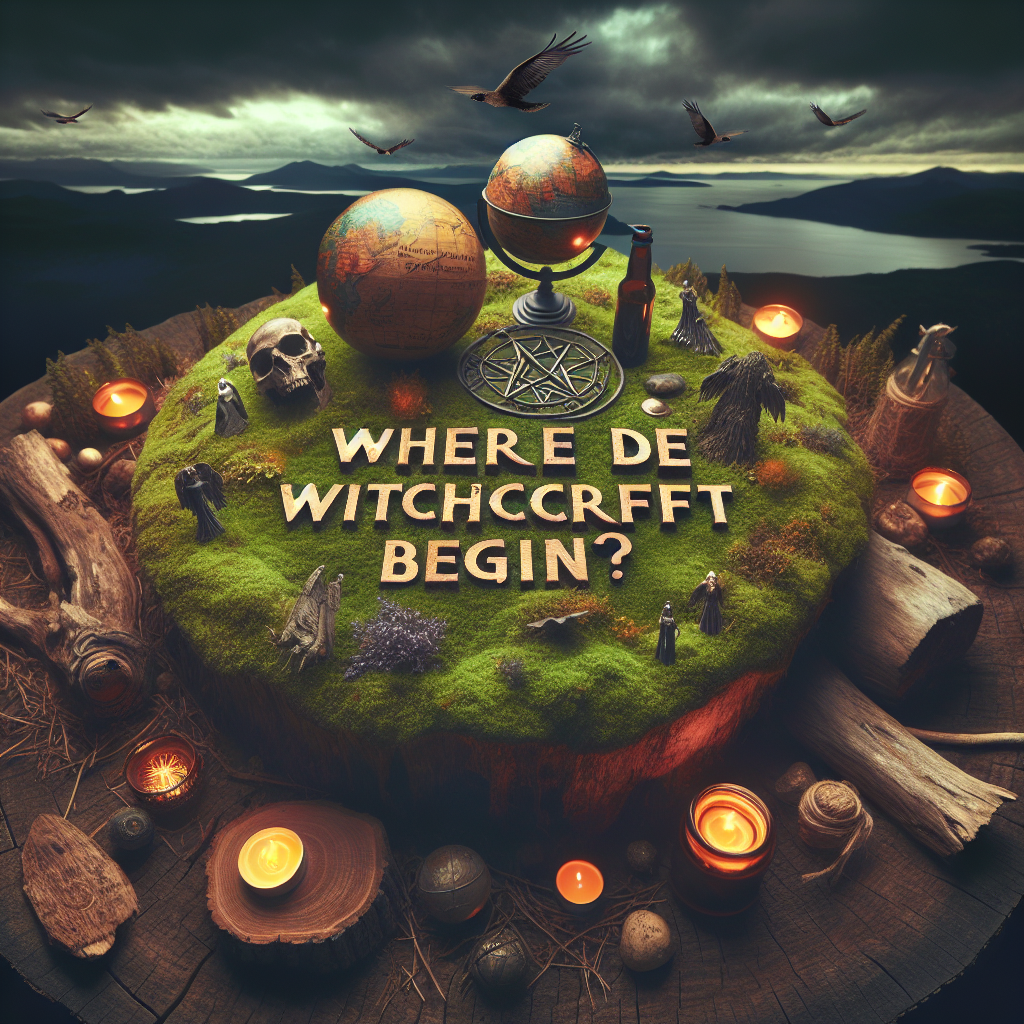As an Amazon Associate I earn from qualifying purchases.

Witchcraft, the practice of magical skills, spells, and abilities, has been both feared and revered throughout human history. The term itself often conjures images of medieval and early modern Europe with its infamous witch hunts and trials. However, this only scratches the surface of the global and historical prevalence of witch-like figures and practices.
Tracing the roots of witcharchy leads us back to prehistoric times when shamanism was widespread across hunter-gatherer societies. Shaman played the roles of healers, spiritual leaders, and intermediaries between humans and the spiritual world. Moving forward in time, ancient civilizations such as the Egyptians, Greeks, and Romans all had their versions of magic practitioners who performed rituals aimed at influencing the natural world or deciphering the will of the gods.
In the medieval period, particularly in Europe, witchcraft became conflated with heresy and was seen as a diabolical pact with malevolent forces. This period marked the height of the witch hunts, a dark chapter in history where tens of thousands of people—mostly women—were accused, often falsely, of witchcraft and executed. It wasn’t until the Enlightenment of the 17th and 18th centuries that the belief in the supernatural power of witches began to wane, leading to the eventual decriminalization of witchcraft in the western world.
In the 20th and 21st centuries, witchcraft has seen a revival, particularly in the form of modern Paganism, such as Wicca. These contemporary expressions of witchcraft often emphasize harmony with nature, the practice of magic, and the worship of pre-Christian deities. In 2014, it was estimated that in the United States, there were up to 1.5 million people practicing Wicca or some form of modern Paganism, illustrating the continued relevance and transformation of witchcraft practices.
Archeological discoveries have played a significant role in understanding the extent and variety of ancient magical practices. For instance, the “Magicians’ Manual,” a papyrus dating from the Greco-Roman period discovered in the 19th century, offers detailed insight into the spells and rituals of that age. Such findings provide a tangible link to the past and showcase the diversity and adaptability of witchcraft across cultures and ages.
Throughout history, societal views on witchcraft have been complex and varied, often reflecting broader tensions and fears. In certain parts of the world today, accusations of witchcraft still have dangerous repercussions, leading to legal and human rights issues that challenge global organizations and activists. Addressing these issues requires sensitivity to cultural nuances and an understanding of the historical context of such beliefs and practices. Despite the passage of time, the fascination and fear connected to witchcraft continue to influence the social, cultural, and legal landscapes around the world.
“`html
Exploring the Origins of Witchcraft: Where and How Did It Start?
“`
Witchcraft, a practice shrouded in mystique and often misunderstood, has its origins steeped in prehistoric times. The beginnings of witchcraft can be traced back to the Paleolithic era, where cave paintings suggest a form of magical thinking among early humans. As societies evolved, witchcraft took on various forms, from the wise women and herbal healers of ancient communities to the feared witches persecuted throughout medieval Europe. Determining the precise geographic location of where witchcraft began is challenging, as various forms of magical practice emerged independently across different cultures worldwide. However, ancient Mesopotamia and Egypt are often referenced as cradles for some of the earliest documented records of witch-like practices. In this article, we will dive deeper into the historical tapestry of witchcraft, unraveling its complex past, different cultural expressions, and the evolution that shaped how it is perceived in the modern world.
Where did witchcraft begin? Understanding its roots takes us back to prehistoric times, long before recorded history. Evidence suggests that the practice of what could be recognized as witchcraft has its origins in the Paleolithic period. Cave paintings and artifacts such as the “Venus” figurines, which may have represented fertility or goddess worship, suggest an early form of prehistoric shamanism. Shamanism involves rituals and practices to make contact with the spiritual world, and it is here that the seeds of witchcraft were likely sown.
The term “witchcraft” as it is commonly understood today, with its connotations of magic, spells, and the harnessing of supernatural forces, can be traced back to the ancient world. The earliest written records of practices resembling witchcraft come from Mesopotamiaround 5,000 years ago. Here, people believed in the supernatural and sought to influence it through rituals and spells. These practices spread and evolved as civilizations interacted with one another.
In ancient Egypt, for instance, magic was a part of daily life. Egyptians believed in the power of heka, a system of magical practices, and used spells for protection, health, and to maintain harmony with the gods. Heka was so integral to Egyptian culture that it was believed that even the gods employed it.
Similarly, in classical antiquity, the Greeks and Romans held strong beliefs in the mystical arts. They had their own systems of divination, curse tablets, and love spells. Notably, the Greeks had the concept of pharmakeia, which refers to the use of drugs, poisons, and spells – tied closely with what would later be understood as witchcraft.
The concept of witchcraft took on a darker association during the Middle Ages in Europe. The widespread belief in witches and their association with the Devil led to the persecution of thousands, especially women, in what has been termed as the “witch-craze”. The infamous witch trials, such as those in Salem, Massachusetts in the late 17th century and earlier in parts of Europe, are a testament to the escalation of fear and superstition surrounding witchcraft.
Understanding the cultural context and the evolution of witchcraft, it becomes clear that it is an amalgam of various beliefs and practices from around the globe. Across different cultures and centuries, what is termed as “witchcraft” has existed in various forms. Animism, shamanism, herbalism, and divination all feature as threads woven into the complex tapestry of witchcraft’s history.
In contemporary times, witchcraft has seen a resurgence through various neopagan movements, most notably Wicca, which emerged in the mid-20th century. Today, witchcraft is practiced by some as a religion or spiritual path, with an emphasis on living in harmony with nature and using magic responsibly.
As for its prevalence, according to a report by the Pew Research Center in 2014, approximately 0.4% of Americans, or around 1 to 1.5 million people, identify as Wiccan or Pagan, indicating the continued interest and practice of what can be termed witchcraft in the modern day. This number, albeit relatively small in comparison to mainstream religions, reflects the enduring legacy and influence of witchcraft’s ancient roots.
Q1: What is the origin of witchcraft?
A1: Witchcraft’s origins are difficult to pinpoint as the practice has roots in various cultures worldwide, evolving from ancient shamanistic traditions, folk magic, and pagan religions. Its development occurred independently across different societies, stretching back to prehistoric times.
Q2: Is witchcraft associated with a single culture or religion?
A2: No, witchcraft is not associated with a single culture or religion. It has manifestations in various forms across different cultures and has been practiced by people of many different religions, as well as by those who follow a specific witchcraft tradition.
Q3: Did witchcraft originate in Europe?
A3: Although Europe has a significant history of witchcraft, it did not originate there exclusively. Various forms of witchcraft-like practices have been identified in Africa, Asia, the Americas, and the Middle East, long before the infamous European witch trials.
Q4: What is the relationship between witchcraft and paganism?
A4: Witchcraft has often been closely associated with paganism, which is a broad term for various polytheistic, non-Christian religious traditions. Many modern witchcraft practices draw inspiration from ancient pagan beliefs and rituals.
Q5: How did ancient civilizations view witchcraft?
A5: Views on witchcraft varied among ancient civilizations. Some saw it as a legitimate practice intertwined with their spiritual beliefs, while others viewed it with suspicion and associated it with dark magic or malevolent acts.
Q6: Was witchcraft always considered evil?
A6: No, witchcraft has not always been considered evil. In many cultures, witchcraft was a part of daily life seen as neutral or even beneficial, used for healing, protection, and other positive purposes. The perception of witchcraft as evil largely stems from later historical events, such as the Christianization of Europe.
Q7: Are there historical records of witchcraft practices?
A7: Yes, there are historical records that provide insights into witchcraft practices, including court documents from witch trials, writings by ancient scholars, and archaeological findings that suggest ritualistic practices resembling witchcraft.
Q8: Did the witch trials only occur in Europe?
A8: While the most well-known witch trials occurred in Europe and North America, accusations and persecutions for witchcraft happened in many parts of the world, reflecting broader human tendencies to seek scapegoats for misfortunes and to fear the unknown.
Q9: How has the perception of witchcraft changed over time?
A9: Perceptions of witchcraft have evolved from seeing it as a powerful societal role, to a maleficent force, and in modern times, a spiritual path or a metaphor for empowerment against oppression. Its image has been rehabilitated somewhat by contemporary witchcraft practitioners and in popular culture.
Q10: Can witchcraft be practiced today, and if so, how is it different from historical witchcraft?
A10: Yes, witchcraft can be practiced today and is by many individuals around the world. Contemporary witchcraft, such as Wicca and other neopagan paths, often emphasizes personal spirituality, connection to nature, and the use of magic for positive transformation. It’s generally more eclectic and less dogmatic than historical witchcraft, which was deeply rooted in the specific cultural and societal contexts of the time.
Conclusion
Witchcraft, as an ancient practice, has its roots in the prehistoric era, where the origins are nearly as old as humankind itself. From these primal periods, shamanistic rituals that can be likened to witchcraft were employed by many early societies across the globe to explain the unexplainable and harness the forces of nature. These spiritual and mystical traditions evolved independently within various cultures, integrating animism, herbalism, and the belief in the supernatural. As civilizations grew, these practices were refined, codified, and sometimes feared or revered, forming the basis of what would eventually be known as witchcraft.
In tracing the beginnings of witchcraft, we recognize its transition from the wise ones or healers of prehistoric tribes to the more structured pagan religions of the classical antiquity, such as those in Egypt, Greece, and Rome, where elements of what we now associate with witchcraft were commonplace. The widespread fear and persecution of witches, most notably during the European witch craze, signals another phase of its development, fueled by religious and societal upheaval. Despite its turbulent history, witchcraft has seen a resurgence in the modern era, particularly with the rise of neopagan movements like Wicca. Thus, witchcraft is not merely an artifact of the past but a continually evolving path that reflects the changing values and understandings about the connection between humanity, spirituality, and the cosmos.
Amazon and the Amazon logo are trademarks of Amazon.com, Inc, or its affiliates.


